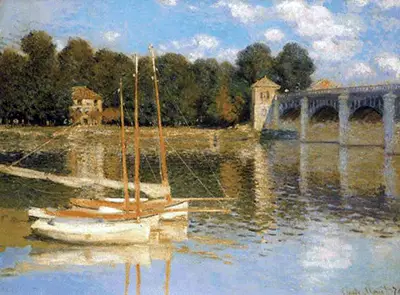One of Monet's defining qualities to modern eyes is his sense of place. Many of us first encounter him in the private space of his garden, almost a dream world of floating light and colour, but one made immediately real through his experiences of it.
However, with many of his French contemporaries, he has succeeded in capturing an impression of a location in a way that brings it to life for us.
Though in many cases their subjects – the elegant seaside towns of Normandy, the Paris of all social classes – may have changed almost out of all recognition, they seem to represent a ‘modern world’ that is still in touch with our own interpretation of those words.
Today, Argenteuil is a satellite town of the greater Paris area, fully subsumed into its commutes, its commerce and its rhythms of life. In the 19th century, however, it was something new: a fashionable resort for inhabitants of Paris, looking to experience two other new phenomena – the day trip and the mini-break.
The development of the railways brought the peaceful riverside of the Seine within easy reach for citizens in need of peace and quiet – whether they were the upper-class 'tout Paris', the middle-class boating-party couple of Edouard Manet’s “Argenteuil”, the promenaders of Seurat’s “A Sunday Afternoon on the Island of La Grande Jatte”, out in their Sunday best clothes, or his upper-working class lads bathing at Asnières, with the local factory chimneys still smoking in the distance.
Claude Monet painted a number of subjects in and around the town – probably including the much-disputed tableau “Bords de la Seine à Argenteuil”, with its broad sweep of the river, its high sky and its plumes of tree-canopy on the far bank. In The Bridge at Argenteuil, he presents a conventional composition, with two moored pleasure-boats in the left foreground, and the bridge itself extending to the far bank from the right of the painting.
It is a choice that leaves Monet much of the fore - and mid-ground to focus on the reflections in the water and the contrast in colours between the dark line of trees, mirrored on the surface, a hint of verdant spring green, the piers of the bridge in shadow, and the pale blue of the sky. In particular, Monet delights in the potential of the river’s surface, as it is ruffled by a current or a light breeze into the slightest, scalloped ripples that catch different colours from the palette around them.
"Colour is my day-long obsession, joy and torment", Monet famously observed. It is a compulsive fascination that has strengthened the comparison between his work and that of JMW Turner, in many ways the forerunner of the Impressionists’ fascination with light, colour and the immediacy of plein air technique. However, if Turner’s work shows light and the elements in turbulence, Monet, in contrast, is all serenity – the quietness and delicacy of light at morning or evening. It is that mood which is most in evidence here: a peaceful view, in passing, of a calm day away from the city.


